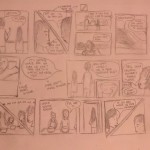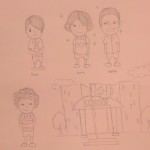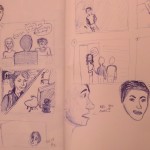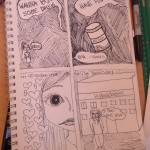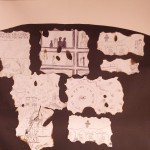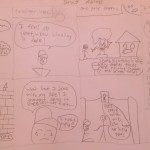Today was the first due date for one of my class’ major projects. I warned them that I was going to collect the artist statements as well as their art projects (social justice comic). If they do not hand in their comics today, then they face the consequence of losing marks. They will lose 1 mark per day including today (the due date) if not handed in. They must also hand in their artist statement with the possibility of a mark deduction as well.
I started off the class by collecting their artist statements. Many seemed concerned and shocked that I would pull such a move. My SA had set up the classroom so that deadlines were
rolling and flexible. The moment I impose solid deadlines, they are in shock. I saw many “deer in the headlights” when I demanded the artist statement immediately after taking attendance. They were not used to such strictness in art class. I proceeded to take them to the multipurpose room where I had my CS student set up the chairs. There they brought their comics and everyone was encouraged to present their project regardless of whether or not they had completed it. I told them to relax and that this is not going to be hard. All they have to do is talk about their art project and to breathe.
The first set of students I went order from one end to the other end. They were told to talk about
1. Title of the comic
2. Concept of the comic
3. Brief summary of their comic
The majority of the students did a very good job in presenting their topic. Understandably, the nerves got to many of them and they slithered/ran back to their seat prematurely. The main thing was that their ideas were conveyed and how they could relate them to social justice. Students who struggled with speaking English used fellow classmates as translators. This was a fantastic tactic and was much appreciated by the class. I feel very fortunate that I can count on these students who were willing to volunteer. In the other class, I went up to help a student with translating his comic. I wanted to make sure that all students were going to participate. At the very end, I did a brief wrap up asking them what they learned from this project and how they felt seeing other people’s work. The overwhelming response to these comics was a sense of disillusionment with reality.
The majority of the comics illustrated popular or anecdotal stories. Many of these ended bleakly with the ending of the story resulting in death of the main character. On the flip side, there were also quite a few that had ended positively presenting an optimistic outlook for the characters in the future. Unfortunately, there wasn’t enough time to ask questions and to give feedback for each student but I could tell that the majority of the students enjoyed being in a different room and sharing work with their peers. Tangential questions also surfaced as a result of the great discussions we had surrounding these comics.
I was disappointed to see that at the end of the day, I only received about half of the student’s projects. This means there will be a lot of late marks! I felt that I was being fair by extending their deadline to a week after spring break. Still, no matter how many times you hammer it into them, if they don’t want to do it, they will not do it. In addition to that, perhaps I had hoped for more ground breaking stories of social justice whereby the protagonist identifies the social issue at hand and comes to a realization that solving this issue is more important than he/she can fathom. Groundbreaking and even shocking discoveries occur in the story that will lead the protagonist to this conclusion. However, the vast majority of the comics that came from my students were ones that depict a problem that ends either positively, negatively, or ambiguously without explaining what the significance of these issues are and why they must be dealt with vigorously. I felt that the stories were more contrived to fit a happy or dismal ending just because I asked for a “resolution”. I believe that they all understood the concept of social justice very well and their work certainly reflects their knowledge and negativity surrounding social issues, particularly the inability to come up with plausible solutions. Perhaps it is difficult to write this type of a comic because solutions to these social issues are hard to come by in the real world let alone in the fictional one. Overall, I am proud of their efforts. I challenged them and they, for the most part, realize that handling social justice issues is an ongoing job that everyone must work together at.
See pictures below:
